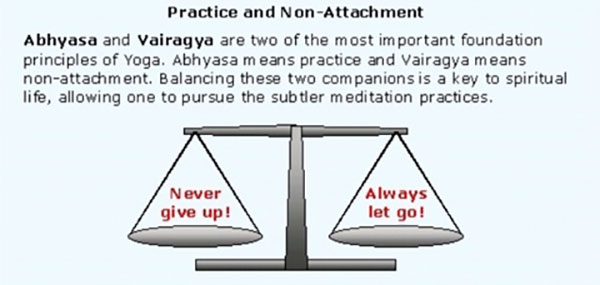Chapter 1 – Concentration/Samadhi Pada – Part 4
Practice & Non-Attachment – Yoga Sutras (1.12 thru 1.14)
Practice (abhyasa) and non-attachment (vairagya) are the two foundational principles on which the entire system of Yoga rests. Through the cultivation of these two principles, all other Yoga practices evolve and eventually mastery over the mind field (chitta/citta) occurs and allows the realization of the true Self (Atman).
Regular practice keeps you headed in the right direction. Non-attachment provides you with a means to continue your inner journey without getting side-tracked by the pains and pleasures encountered along the way.
Abhyasa and Vairagya go together as companion practices. They are the tools for mastering (nirodhah) the many levels (fluctuations) of the mind, thus allowing the experience of the true Self.
Practice means having an attitude of persistent effort to attain and maintain a state of stable tranquility. Non-attachment involves learning to let go of the many attachments, aversions, fears, and false identities that are clouding the true Self.
In order to properly practice and cultivate non-attachment, it is necessary to become consistently better at discriminating between your actions. Distinguish between utterances, and thoughts that take you toward the goal of union, and those which tend to separate and divide.
Developing and increasing discrimination is both a foundational practice and a subtle tool for advancing the inner journey.
Yoga Sutra (1.12) – abhyasa vairagyabhyam tat nirodhah. Abhyasa means practice (also cheerfulness). Vairagyabhyam is non-attachment, indifference, or dispassion. Tat means this (or those). Nirodhah, in this context, means control, regulation, restraint or mastery.
Translated, this sutra means controlling thought patterns via of a balance between cheerful practice (abhyasa) and non-attachment (vairagya).
Yoga Sutra (1.13) – tatra sthitau yatnah abhyasa. Tatra means “of these two” (abhyasa and vairagya). Sthitau represents stability, consistence, and undisturbed calmness. Yatnah is effort, persistent exertion, or sustained struggle. Abhyasa means with (repeated) practice.
This Sutra is generally translated – Practice (abhyasa) by applying the chosen effort and actions to establish a stable and tranquil state (sthitau). Also by resolutely and consistently adhering to one’s practice until the attainment of a stable and undisturbed calmness prevails.
A note on Sthitau as a stable form of tranquility – This stability is more than just a matter of regaining your peace of mind when it has been lost. It‘s taking the extra steps when planning your life to support meditation, not only formally (like sitting meditation) but also when in “the marketplace.”
Yoga Sutra (1.14) – sah tu dirgha kala nairantaira satkara asevitah dridha bhumih. Sah means the same, that (practice). Tu is but or in any case. Dirga Kala (Dirgha = long – Kala = time).
Nairantarya is continuous, uninterrupted. Satkāra means seriousness or care. Adara is respect and consideration for others. Asevito (from asevita) means practiced, followed, or continued. Drdha means sound, well founded. Bhumiḥ (from bhumi) basis, foundation or earth.
Put together all these words mean: When that practice persists for a long time, without a break, and with sincere devotion. Then it becomes firmly rooted like a stable and solid foundation. Achieve success through a sound and continuous practice over an extended period, carried out in a serious and thoughtful manner.
Because consistency is such an important part of practice, choose a practice to which you commit yourself. Resist being overenthusiastic when establishing your practice and taking on more time (or energy) than you have. It is better to start by choosing a level of practice that you know you can maintain without a break. As your lifestyle changes to give you more time for meditation you can increase this time to include sessions of longer duration.
~Rae Indigo
Next in this series, Part 5 (Practice and non-attachment, cont.), Yoga Sutras 1.15 thru 1.16.
